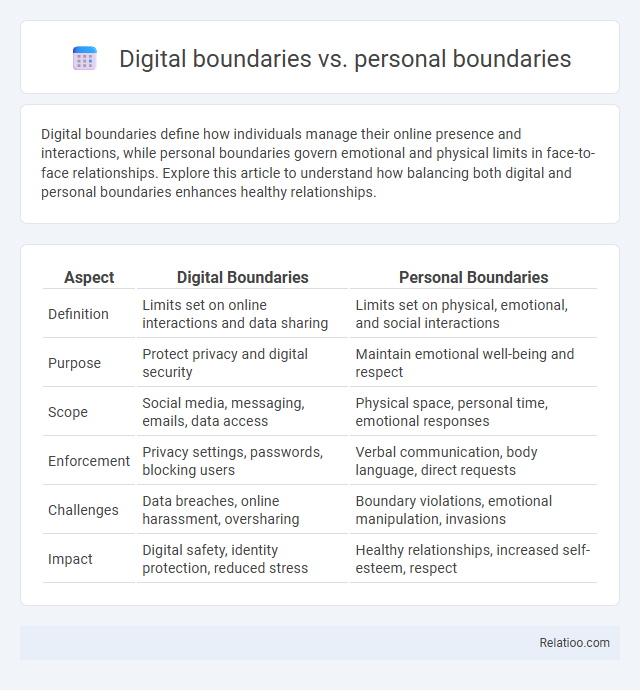Digital boundaries define how individuals manage their online presence and interactions, while personal boundaries govern emotional and physical limits in face-to-face relationships. Explore this article to understand how balancing both digital and personal boundaries enhances healthy relationships.
Table of Comparison
| Aspect | Digital Boundaries | Personal Boundaries |
|---|---|---|
| Definition | Limits set on online interactions and data sharing | Limits set on physical, emotional, and social interactions |
| Purpose | Protect privacy and digital security | Maintain emotional well-being and respect |
| Scope | Social media, messaging, emails, data access | Physical space, personal time, emotional responses |
| Enforcement | Privacy settings, passwords, blocking users | Verbal communication, body language, direct requests |
| Challenges | Data breaches, online harassment, oversharing | Boundary violations, emotional manipulation, invasions |
| Impact | Digital safety, identity protection, reduced stress | Healthy relationships, increased self-esteem, respect |
Understanding Digital Boundaries
Understanding digital boundaries involves recognizing the limits set on online interactions to protect privacy, mental health, and personal information from digital intrusion. Digital boundaries differ from personal boundaries by specifically addressing the control over how much of one's digital life is shared, including social media usage, data sharing, and online communication. Clear digital boundaries foster a healthier digital lifestyle by preventing cyberbullying, identity theft, and emotional burnout in virtual environments.
Defining Personal Boundaries
Personal boundaries define the limits and rules you set for acceptable behavior and emotional interaction in your life, protecting your mental and emotional well-being. Unlike digital boundaries, which specifically regulate your online interactions and privacy, personal boundaries extend to all aspects of interpersonal relationships. Understanding and clearly defining your personal boundaries empowers you to maintain healthy, respectful connections and prevents emotional overwhelm or exploitation.
Key Differences Between Digital and Personal Boundaries
Digital boundaries define the limits you set in online interactions, controlling access to your digital life such as social media, email, and virtual communications, while personal boundaries involve your emotional, physical, and mental limits in real-world relationships. The key differences lie in their contexts and enforcement methods: digital boundaries require managing privacy settings and online etiquette, whereas personal boundaries depend on direct interpersonal communication and physical space. You must recognize that respecting digital boundaries protects your online identity, whereas personal boundaries safeguard your emotional well-being and physical safety.
The Importance of Setting Healthy Boundaries
Setting healthy digital, personal, and hybrid boundaries is crucial for maintaining mental well-being and fostering respectful relationships. Digital boundaries involve managing screen time and online interactions to prevent burnout and privacy invasion, while personal boundaries safeguard emotional and physical space during interpersonal exchanges. Prioritizing these boundaries helps reduce stress, enhances self-respect, and promotes balanced engagement in both virtual and real-life environments.
Common Challenges in Maintaining Digital Boundaries
Common challenges in maintaining digital boundaries include the blurring of work-life separation due to constant connectivity on devices and social media platforms. Personal boundaries often become compromised as individuals struggle to disconnect from digital communications, leading to stress and burnout. Establishing clear digital boundaries requires consistent effort to limit screen time, manage notifications, and set expectations with others about availability.
Impact of Technology on Personal Space
Digital boundaries define the limits set around your online presence and interactions, while personal boundaries govern physical and emotional limits in face-to-face relationships. The impact of technology on personal space often blurs these boundaries, making it challenging to maintain privacy and emotional well-being. Clear digital boundaries help protect your personal space from digital intrusion and preserve healthy relationships in an increasingly connected world.
Practical Tips for Establishing Digital Boundaries
Establish clear time limits for device usage and designate tech-free zones to maintain a healthy balance between digital engagement and personal life. Use privacy settings, block unwanted contacts, and manage notifications to protect your mental space and reduce digital stress. Regularly evaluate your digital habits and communicate your boundaries clearly with friends, family, and colleagues to ensure mutual respect and understanding.
Navigating Boundaries in Online Relationships
Navigating boundaries in online relationships requires understanding distinctions between digital boundaries, which regulate online interactions and content sharing, and personal boundaries, which protect emotional and physical well-being. Digital boundaries involve managing privacy settings, controlling digital footprints, and deciding the extent of information shared on platforms, whereas personal boundaries focus on setting limits to maintain respect and autonomy in interactions regardless of the medium. Balancing these boundaries effectively fosters trust, promotes respectful communication, and prevents overexposure or emotional discomfort in virtual relationships.
Respecting Others’ Boundaries in Digital Interactions
Respecting others' boundaries in digital interactions involves understanding the distinctions between digital boundaries, personal boundaries, and digital boundary as a concept. Digital boundaries refer to limits set around online communication and data sharing, while personal boundaries encompass emotional and physical limits in both online and offline contexts. Your awareness and adherence to these boundaries ensure respectful and ethical interactions, fostering trust and privacy in digital environments.
The Future of Boundaries in a Digital World
Digital boundaries define the limits set on online interactions and data sharing, while personal boundaries refer to individual emotional and physical limits in daily life. The future of boundaries in a digital world will integrate advanced technologies like AI-driven privacy controls and virtual reality etiquette to protect users' autonomy and mental well-being. Evolving digital boundary frameworks will prioritize adaptive security measures and ethical algorithms to balance connectivity with personal space in increasingly immersive digital environments.

Infographic: Digital boundaries vs Personal boundaries
 relatioo.com
relatioo.com